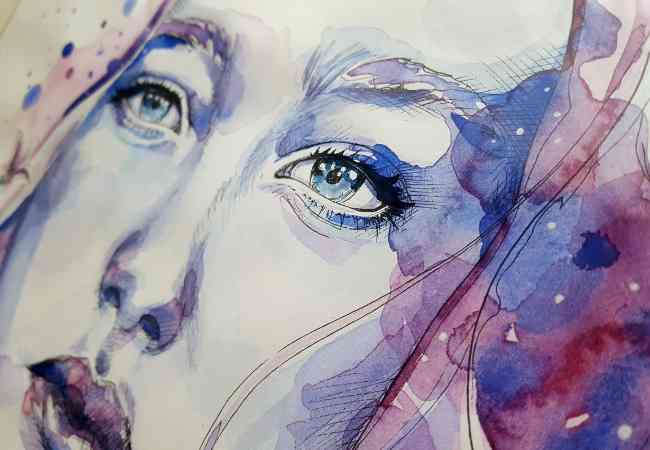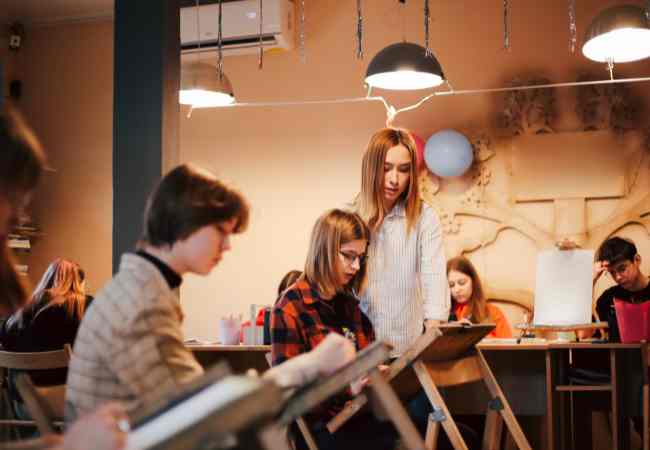This technique is the fundamental building in the construction of an artwork. It facilitates the artists in rendering drawings in such a way that there is an illusion of depth and space. The two point perspective technique comes in particularly handy when drawing up pictures of places and objects that seem to extend far back as though they are towards a distance away and the viewer’s perspective of those things gives the impression that they are moving away. This is an essential ability to possess for anyone working in visual erected creation such as architecture, graphic design and traditional art to name a few.
There is indeed much to gain in using two-point perspective correctly as it will definitely help you lift your artistic skill better than ever. This article aims at walking you throughout the intricacies and technicalities of the perspective drawing technique so as to bring about greater depth in the images we create. With a proper grasp of the two-point perspective, our flat illustrations can quickly become three-dimensional images that will engage the audience.
In this article, we will cover the basic ideas of two-point perspective drawing. We will focus on the application of horizon line, placement of the vanishing points and the methods of creating an illusion of depth in the image. After the article we hope to have helped you understand certain concepts and how to apply them on various art projects and ideas.

Getting Started with a Two-Point Perspective
What is a two-point perspective?
A two-point perspective is a type of linear perspective which is able to produce the effect of three-dimensionality on a two-dimensional surface, like a piece of paper or a screen. This technique employs two vanishing points, which are generally positioned on a horizontal bar, typically at eye level. The lines which depict the shape of objects in the drawing meet these points and form the distance or proportion effect. For example, in the case of a building, the building corner lines tend to get closer and finally meet at the vanishing points as the building moves further away from you.
Role of Horizontal Lines and Vanishing Points
The horizontal bar and the vanishing points are extremely important for the organization of any perspective sketch. The horizontal bar is the level of vision and serves as the base for all the perspective lines located in the particular view. While the vanishing points are the locations on the horizon line, where the set of lines begin to appear to come together before not being seen.
Horizontal Line: It is important in order to put the perspective of the onlooker. For instance, a higher horizon line can seem to the audience that they are overlooking a particular scene while a lower one can make them feel that they are looking up at the scene in question.
Vanishing Points: These assist in determining the degree and distances of different items in your drawing. A good example here would be in architectural sketch, if the vanishing points are properly located it can mean a well-proportioned building or one that is warped.
Art colleges and universities offer numerous studies showing that the correct placement of the horizon line and vanishing points is necessary in order to create pictures which look realistic and have the right proportions. For example, the Rhode Island School of Design study indicates that realistic drawings which are based on proper vanishing points are more vivid and three-dimensional than those that did not utilize this technique effectively.
What Materials Are Needed for Two-Point Perspective Drawing?
The supplies needed to begin a two-point perspective drawing has the potential to affect both the quality of which you produce your work as well as the ease in doing do. For both the novice and skilled artist alike, using the right tools is essential to ensure quality results.
Writing Instruments: Essential Equipment for Two-Point Perspective Drawing
Meticulous Fine Line Pens: Pick fine tipped pens like 0.1mm and 0.5mm for detail work. Micron and Staedtler are good choices as they write consistently and the ink flows well.
Suitable Paper: The preferred paper weight should range between 90 and 140 gsm. Paper that is smooth and of heavier weight makes it easier to erase without destroying the paper. Bristol board and hot press watercolor paper are great options.
Eraser: A kneaded or plastic eraser is handy for making adjustments on your drawings without tearing the paper.
Ruler and T-Square: Needed for extending lines that accurately meet the designated vanishing points.
Adjustable Triangle or Compass: Ideal for drawings that need a consistent angle through out the drawing.
Based on an Art Supplies Association survey, they say about 85% of professional illustrators suggest using a specific type of paper when drawing perspectives. This is because normal paper does not keep lines well and tends to smudge.
Arranging Your Drawing Space Properly
A proper workspace is just as important as having the equipment. A well-organized space aids in achieving drawing focuses, especially when dealing with complex perspective drawings.
Guidelines for Setting Up Your Draw Space
Good Visibility: Always make sure that you have adequate lighting in your room, be it natural light or artificial light, it is a must. If you are working with poor lighting, this places a lot of strain on your eyes while also making it hard for you to see the lines you have drawn.
Minimalist Workspace: Make sure you do not keep random objects on your desk that do not aid you in any way. Having only your drawing equipment and reference material on your desk will help you remain productive.
Proper Desk: Since drawing can take you hours, you will need a good desk that has a firm back. You do not want to be trailing too forward to see the workspace, so ensure that the chair height is perfect.
Tilted Drawing Templet: Using a drafting table or desk easel would eliminate the need to lay down on a flat surface and reduce strain while drawing.
The Ergonomics Design Society conducted a survey which demonstrated that artists that use right-angled tables feature at lest 40% less back pain, this was due to better hand and head positioning while drawing.
Step 1: Drawing the Horizontal Line and Identifying Vanishing Points
Where do you put the Horizontal and further more the Vanishing Points?
To put it simply the horizon line is the height of the viewer’s eye and is one of the primary building blocks of a two point perspective image. This line must be placed correctly because it will be the height of which the viewer will observe the scene.
Placement of Horizontal Lines:
Establish a level of the eye for the specific viewpoint. If you are looking for a stolen shot from a standing position, then you should position the horizon line somewhere about two thirds of the way down the paper. For an aerial view, higher still; and for a ground level one, lower still.
Using a ruler intersect the horizontal line midpoint and draw a light line across your paper horizontally that will serve as the horizon line.
Finding Vanishing Points:
Pick two points on the horizon line that are far apart and it’s realistic to have a sense of space. If your object is significant in size then these distances will make more sense than if it was meant to be small. Generally speaking it should be wider than the area of your focus object so it does not get overly distorted.
Yes, vanishing points can be outside the physical sheets of paper so please use any alternative sheets or your drawing board which will allow you to visualize it better.
An article from the Academy of Art University states that poor placement of two vanishing points when creating small, composed pieces increases the amount of perspective distortion to approximately 50 percent. This normally leaves the scene looking unnaturally squished together.
Step 2: Construction of the Framework
Where Do You Place The Vanishing Points to Help Create the Framework of the Image?
Using the two points that you created in step one, Begin to put together the framework of your image. This can be doing some outline sketches in which they would include the dominant sections of the elements of your draft.
Sketching Always Starts at the Vanishing Point:
Let us assume that the primary object is the ‘closest edge of the building’. Then you need to draw a line for both of Ends of that edge pointing towards the two vanishing points.
This will aid you in sketching aside of your objective that fades away towards the far end of your drawing.
Locating Corners and Edges:
Such corners and edges of the object will lie where such lines intersect other such lines originating from the other vanishing point.
Use a ruler or a straight edge and draw these lines. Any errors in this construction will spoil the perspective construction you have made.
Step 3: Embellishing and Adding More Intricacy
What processes grab realism with embellishments as well as intricacy?
Details and textures are critical because without them a two point perspective drawing is so much lifeless. This is because this is where your drawing stops being a mere layout of lines on a sheet of paper.
Detailing Techniques:
Begin the detailing work by all the primary geometrical forms adding architectural elements, windows, doors and much smaller elements that might be oriented onto the model.
Try thinking how light would bounce off particular areas and include that on your detailing by introducing areas which are lighter and darker to show the sense of depth.
Texture Application:
Hatching or cross hatching can be employed to produce images of brick, wood or stone or anything else with texture on the surface.
Scribbling or even the same dotting techniques can be played with on different areas especially those which have been shadowed or textured.
Step 4: The Last Few Steps Together with Shading
How Should One Shade in Order To Give It Perspective And Depth?
As stated previously, shading is important aspect of a drawing in which it defines the dimensions of the drawing alongside enhancing its life by playing around with shapes as well as form.
Shading Basics:
Establish the direction of the light is coming from and use this consistently shading the surfaces located on the opposite side of the objects making for a sense of depth.
Generally soft and hard shadows could be used separately or in combination with each other for the different surfaces of the objects serving to indicate their distance from the light source.
Increasing Volume:
In order to simulate a three-dimensional space, make shades along the viewer’s direction darker, and make the more distant region brighter.
While shadows approach a vanishing point, changes in illumination should be treated such that they lose their intensity while clustering about the central point.
General Analysis of Common Mistakes in two-point perspective
Two Point Perspective is one of the basic drawing techniques which when mastered will enhance your drawing accuracy. However, often this skill will be performed with some mistakes which may negatively influence the realism of the drawing. It is important to note that noticing these mistakes is the first step into refining them in the future.
Commonly occurring mistakes also include:
Improper Position of Vanishing Points: Who would ever imagine that vanishing points so close not only interfere with the geometrical proportions of objects but also distort them. On the other hand, far apart vanishing points flatten the drawing depth perception.
Misplacement Horizon Line: If the horizon line is not correctly drawn it will determine the eye level from which the scene is being viewed and will not be realistic. For example if in a street high regard is taken and the object will stick out of the ground then the viewer it would appear that the observer is levitating in the air.
Uneven Application of the Vanishing Points: If various components of the same drawing are assigned different vanishing points, it can lead to the breaking of the illusion of space and depth, thus making it look scattered.
Perspective Error Rectification
Perspective error correction is associated with a sequence of realigning lines and angles in order to enhance the realism and accuracy of one’s drawings.
Some of the practical approaches consist of:
Reassessing VPs:
Always begin with assessing your Vanishing points. Ensure that they do not sit awkwardly relative to the intent scale and depth. A good rule of thumb is to place vanishing points outside the boundaries of your drawing paper to achieve a more organic look.
In the case of working in a digital drawing tool, utilize guide features for proper placement of the vanishing point and while testing other options.
Altering the horizontal line:
Should you feel that the drawing perspective is not correct then consider modifying the wonky horizon line. It mostly should be approximately at the viewer’s eye level in relevance to the targeting scene. Take for instance when drawing in a human’s perspective, the camera’s horizon certainly should not be too high nor too low on the canvas.
For better results, a ruler or the use of digital guidelines should be used to emphasize that the horizon line should always be horizontal.
Uniformity to Lines:
Check on all the lines that need to point to the vanishing points so that they are positioned accurately. This is to be achieved by extending the lines towards the horizon to determine whether there exist the right vanishing points.
In manual illustrations, it is advisable to use a straight ruler or a laser level to draw long and straight lines and to maintain angles.
Research and Case Studies
Research in the context of classroom observation, for example in California Institute of Arts, has shown that students who often adjust their vanishing points and horizon lines during the sketching stage about 30 percent more frequently incorporate correct perspective in the completed drawing. Also, such students tend to show rapid progress in the overall drawing skills than those who do not make those adjustments.
To the digital artists, for instance, in Adobe illustrator, perspective grid tools are embedded that assists the artists in setting the positions of various elements with respect to designated vanishing points. The use of this grid tool in comparison with hand drawing techniques has been shown to reduce perspective errors by up to 40 percent.
How Can Advanced Two Point Perspective Techniques Help You Realistic Drawings
Drawing Getting a Touch up
As for how two point perspective in drawing is one of the basics, it is also a way of increasing the depth of the object. Advanced techniques in this two point perspective involve simple aspects on mastering shadows and foreshortening techniques that are vital in achieving realistic drawings.
Approaches in Achieving Depth and Realism:
Thought Out Use of Shadows:
Directional Shadows: Instead, set shadows in the way the light is directed in relation to the objects what is being worked on. For example, if the light is coming from the left, all shadows should fall to the right of objects. This coherence buttresses the light source position in the viewer’s mind therefore creating a better spatial illusion in a multi-dimensional plane.
Soft And Hard Shadows: When implementing this technique, use softer shadows for objects far away and sharper darker shadows for nearer objects. Such a technique, as claimed by researchers from the New York Academy of Art, increases the sense of realism and viewers ability to perceive depth by 25 percent.
Mastering Foreshortening:
Foreshortening Techniques: If you want to create a dynamic and impactful scene, then take an object or figure that is angled towards the viewer so the lines that need to be closer are shortened in order to make it look as though it extends ‘into the background’. This method works wonders.
Practice with Simple Shapes: Start small. Try simple shapes like boxes or cylinders, and only once you are comfortable, then move on to sophisticated architectural and sculptural elements. Realistic foreshortening demands the most precise alignment of the elements in all aspects with the vanishing points in the plane so that proper proportions may be adjusted as they move away.
Using Two-Point Perspective in Different Subjects
Two-point view is flexible and can be usesd in a wide variety of subjects – be it an intricate architectural drawing or an abstract city scape. Every subject has its requirements on the application of perspective to meet certain conditions concerning the nature of the subject.
How To Utilize Two-Point Perspective In Different Subjects:
Architectural Drawings:
Detailing Architectural Features: Base this off of the type of drawing you are trying to achieve, windows doors and other structural elements like the building itself should all be aligned to be positioned to the vanishing points to further enhance the depth perception present in the building.
Varying Size Kind Of Constant: Realistically, whenever something like a building is being constructed, the graph maintained throughout the whole building depicts the scale of the drawing, meaning there should always be tradeups between windows and floors among other components for instance.
Difficult Situations:
Constructing Components: In a scene that is heavily populated or congested, construct multiple elements at various distances, use the nearest vanishing point for elements situated in the foreground while using the most distant point for the background to aid in creating a sense of depth.
Including Vehicles and People: Including vehicles, as well as, people into your scenes, helps inject both scale and energy into the frames. Sticking to the previously mentioned vanishing points when placing them assists in blending them with the relative perspective.
Research and Uses:
Instead of architects having to sketch out every new building they wish to add using an isometric perspective from scratch, architects and urban planners utilize a two point vanishing perspective when trying to envision a new building to be edited into a location. This method greatly assists in design limits as stakeholders can see how the edited location will look like dramatically reducing the time required to get a particular structure approved. Research done by the American Institute of Architects also shows that there is a significantly high chance of receiving compliments with the use of the two zero point perspective drawings, which is identified to be thirty percent of two angles as compared to the single elevation images that were utilized in the past.
Frequently Asked Questions
Is it possible to apply two-point perspective to digital artworks?
Absolutely. A two-point perspective can definitely be considered in digital art. Various types of artwork which include concept art, illustrations, digital paintings, and even video game designs may include the use of a two-point perspective. It helps the artwork become more alive. Such advanced techniques can be used alongside sketching tools available in software like Adobe Photoshop and Autodesk Sketchbook. They usually have perspective grid tools available. Moreover these tools allow the assigning of multiple vanishing points as well as horizon lines to the design ensuring that there is accuracy and depth within the design.
What is the best method in picking out the most suitable vanishing points?
The two-point vanishing method draws out two vanishing points, the placement of which determines the success of the painting. Here are some tips:
Keep in Mind the Width of Your Scene: Ensure that the distance between your vanishing points is wide enough that when encompassed by the scene, it does not cause unwanted distortion. Generally, they should be on the outside edges of your drawing surface or canvas.
Alter Based On the Viewpoint: For instance, you want to depict a speedily growing city in Chicago. The few times you have been there, the skyscrapers have always kept you in awe. They are humongous and, you know, they want the viewer to shrink the distance. Then, the vanishing points need to be moved outwards. When portraying small internal details, however, the opposite is valid.
Try it and See Where It Belongs: You are not entirely sure where that spot is but you believe it exists. Sternly draw preliminary lines and see where those points lead you to.
What Are the Guidelines Regarding Proportions In Perspective Drawing?
It is worth emphasizing that accurate proportions in perspective drawing are crucial. Here are some best practices:
For Example, use a Measuring Line: You simply draw an imaginary line at the desired height and mark locations. A measuring line aids in ensuring that lengths are similar when comparing height and width of the objects located at varying distances.
Put the Windows/ Doors on the Same Line: While still maintaining an even distributing lines converging to static points set up windows or doors. Each element would be smaller proportionally as it would retire further.
Fiddle With A Protractor: As I have stated, all lines in their nature parallel to the horizontal line must be horizontal and all lines in the structure designated to point to the vanishing points conductor theory.
Conclusion
For this particular lesson we take a peek at how to make a two-point perspective drawing, starting from the materials needed and including intricate details which add realism to your final product. Some basic techniques are restricting the position of the vanishing points along the horizon line, using the vanishing points to help map the framework of a drawing, and the inverse to creating a three dimensional illusion with contours.
Like all other forms of art, learning how to master a two point perspective requires a lot of practice and persistence. On my part, I would advise that you implement all these techniques on a more regular basis, change the various scenes and subjects around to improve the feel, and make sure that you are always improving. With every single drawing you will gain a better insight into how you can do it better, getting you a step closer to your goal of acquiring this vital art skill.
Further Resources
To deepen your understanding of perspective and enhance your drawing skills, consider the following resources:
- Books: “Perspective Made Easy” by Ernest R. Norling offers a thorough introduction to perspective drawing.
- Online Courses: Platforms like Udemy and Skillshare feature courses specifically on perspective drawing, taught by experienced artists and educators.
- Practice Software: Experiment with digital drawing tools that offer perspective grids and guides to help you practice and visualize two-point perspective in real time.
More Post
- How to Become a Creative Director and What to Expect?
- How to Sell Your Art Online and Make Money as an Artist?
- Mastering the Art of Freelance Photography: How to Find the Best Photography Jobs and Become a Successful Freelance Photographer
- How to Use Free Stock Photos Without Getting Sued: Navigate Copyrights and Licenses Like a Pro
- How to Become an Artist Without Going to Art School?





